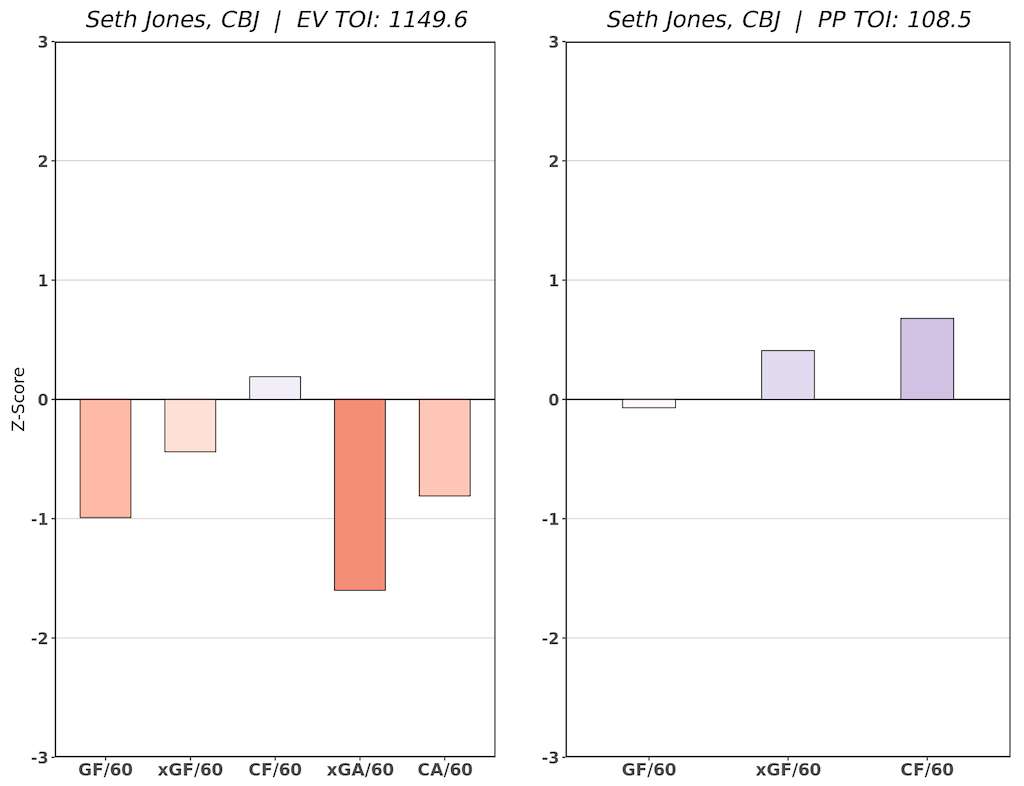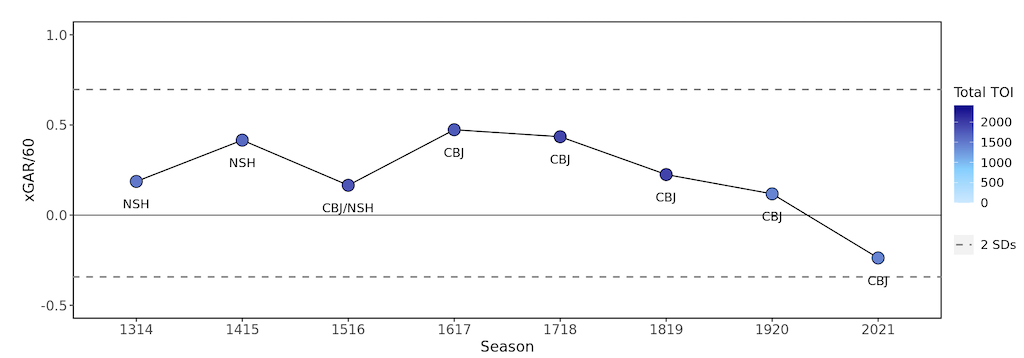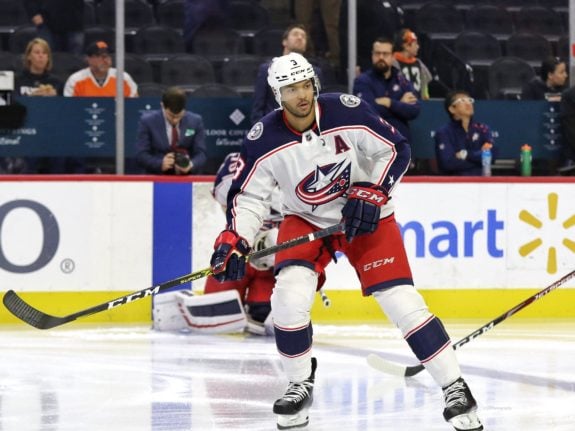In what was a bit of shocking news, Sportsnet’s Elliotte Friedman reported over the weekend that Columbus Blue Jackets defenseman Seth Jones will not be re-signing with the team and intends to test free agency in 2022. With the news, The Athletic’s Aaron Portzline indicated that it’s highly likely the Blue Jackets will trade Jones since he has no plans to sign an extension (from ‘Change of plans: Blue Jackets likely to trade Seth Jones without contract extension’, The Athletic – 5/30/2021).
It’s no secret that the New Jersey Devils need to improve their defense. And when a name like Seth Jones comes up on the market, it’s going to catch people’s attention. He’s consistently among the top point-producing blueliners in the league and logs big minutes playing a top-pair role.
But what Jones is as a defenseman and what he’s perceived to be are two different things. He’s not as bad as some make him out to be, but there are some serious red flags in his game. The Devils may be flush with cap space, but they have to use it wisely. In this case, targeting Jones would go against that, especially with the money he’ll command as a free agent. Let’s look at why general manager Tom Fitzgerald and the Devils should stay away from trade talks.
Jones by the Numbers
On the surface, it’s easy to see what’s so appealing about Jones. He’s 6-foot-4, 209 pounds, can skate well, and puts up points. He’s averaged over 25 minutes of ice time in each of the last three seasons, and he’s a right-handed shot. These check all the boxes for what the Devils need to improve on their blue line this offseason. But when you open up the hood and inspect what’s underneath, it’s not what you’re expecting to find.
Related: Devils’ RFAs: New Deals Unlikely to Affect Offseason Plans
Jones logs a lot of minutes, but how he handles those minutes should give you some pause. In each of the last three seasons, he’s had a goals above replacement (GAR) of 3.2, 4.5, and -5.8. When combined, that equates to a GAR of 1.9, ranked 184th in the league among defensemen and puts him among depth defenders such as Greg Pateryn and Braydon Coburn. For someone who’s considered a shutdown defenseman, his defense has been worth a GAR below replacement level in two of the last three seasons.
What’s troubling about Jones is the significant decline in play this past season. It’s not a stretch to say he was one of the weakest defenders in the league in 2020-21. His overall GAR of -5.8 was sixth-worst in the entire NHL among defensemen. His even-strength defense was worth a GAR of -3.4, ranked 10th-worst among blueliners. Not surprisingly, he had a noticeably negative impact at even strength:

Blue Jackets head coach John Tortorella seemed to notice that Jones’ play has slipped as of late. Jones went from playing 40.2 percent of his ice time against elite competition in 2018-19 to 31.3 percent in 2019-20, per PuckIQ. It slipped a bit again in 2020-21, though only to 29.7 percent. His Corsi percentage (CF%) against elite competition dropped from 52 percent in 2018-19 to 48.9 in 2019-20 and down to 42.2 percent this past season, which is a significant decline.
Another metric that can be useful in dissecting a defenseman is expected GAR (xGAR) because it puts less emphasis on finishing. And with Jones, his xGAR has declined in each of the last three seasons, so that drop in ice time and success versus elite competition doesn’t seem to be a coincidence.

There’s a better defenseman in Jones. He’s not as bad as he was this season, and someone who skates as well as he does for his size could do well in a rush-based system like the Devils run under Lindy Ruff. But his decline in play over the last three seasons is a significant concern. And a recent transaction should serve as a warning for the Devils not to take a gamble on a defenseman who showed some red flags in his game.
Subban Trade Should Serve as a Reminder
When the Devils acquired P.K. Subban back at the 2019 Draft, they hoped he’d help turn around a blue line in desperate need of it. At the time, Subban was coming off a down season with underlying numbers that raised some red flags. But it also looked like it was a one-off and that he’d rebound (I even wrote as much). As it turns out, that wasn’t the case. Subban ended up having the worst season of his career in 2019-20, and he’s never regained his pre-trade form.
Subban’s GAR in his final season with the Nashville Predators was -0.6. Part of that was likely due to an injury he suffered in December of 2018. Though the Predators weren’t concerned about it, it’s hard to know how much that affected his game. But he has not posted the same results since then — he’s been a below replacement-level player with the Devils.
Subban’s game did recover a bit this past season, even with an increase in quality of competition. Ruff’s rushed-based system seemed to help him find his offensive game again. And it’s hard to imagine he can’t build on that if the Devils make enough improvements this offseason to lighten his workload in 2021-22.
Jones, like Subban, had an injury that preceded some of his struggles. He underwent surgery in Feb. 2020 to repair a fractured ankle he suffered against the Colorado Avalanche that kept him off the ice for 8-10 weeks. With the pandemic pushing back the start of 2020-21 to January, that gave him plenty of time to get back into form, even with the Blue Jackets in last season’s playoff bubble in Toronto. Could it still have affected him this season? You definitely can’t rule it out.

But this is where the Devils’ experience with Subban should serve as a cautionary tale. A player whose performance notably fell off after an injury should be enough to say, “OK, there’s too much risk involved here.” At the same time, there are some differences between Jones and Subban’s situations. Subban was a high-end defender the previous two seasons before his injury; he was a Norris Trophy finalist in 2018. But as stated above, Jones’ play has declined in each of the last three seasons, so it doesn’t look like a one-off as Subban’s did at the time.
Jones’ Price Means Devils Will Have More Sensible Options
Jones is going to be a free agent in about a year and will get a significant pay raise from his current $5.4 million cap hit. Time will tell what a new contract looks like, but it wouldn’t be a surprise if an extension ended up costing north of $7 million a year (or even more) for seven or eight years.
The Devils have over $37 million in cap space this offseason. I hear the argument, “well, they need to spend money to get better, so take a chance on Jones.” But you still have to use cap space wisely; once you lose cap space, it’s incredibly hard to get back. That’s something to keep in mind with Jack Hughes, Miles Wood, Jesper Bratt and Pavel Zacha all restricted free agents next offseason.
Related: Devils 2021-21 Report Cards: Defensemen
In Jones’ case, his play suggests he isn’t worth the kind of money he’s going to get (that doesn’t count the assets the Devils would have to give up to acquire him). That doesn’t mean he sucks and can’t play hockey. If he were to cost less and were a second-pair defender, then this would be a different discussion. But that’s why it’s important to see what he does with the minutes he receives because it might not be the same as his perception.
Jones is going to be a hot commodity on the trade market this summer, but the Devils would be best off looking elsewhere. Fortunately, with the expansion draft coming up, there’ll be other blueliners (Ryan Graves, Matt Dumba and maybe even Devon Toews, to name a few) who’ll be available on the trade market. There’s also the looming free-agent sweepstakes of Dougie Hamilton, who’d be well worth the time and money over Jones if they’re going to pursue a high-end defender, assuming he makes it to free agency. It’s clear the Devils will have options to improve their defense, and most of them will certainly be a wiser investment of cap space and assets than Jones.
* * *
Advanced stats from Evolving-Hockey, except where noted